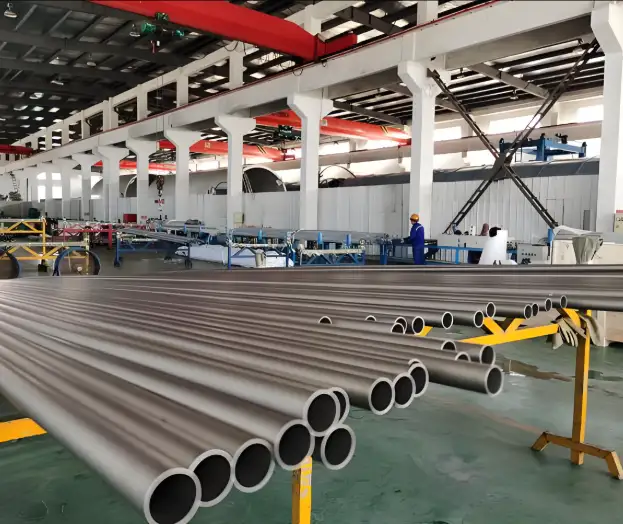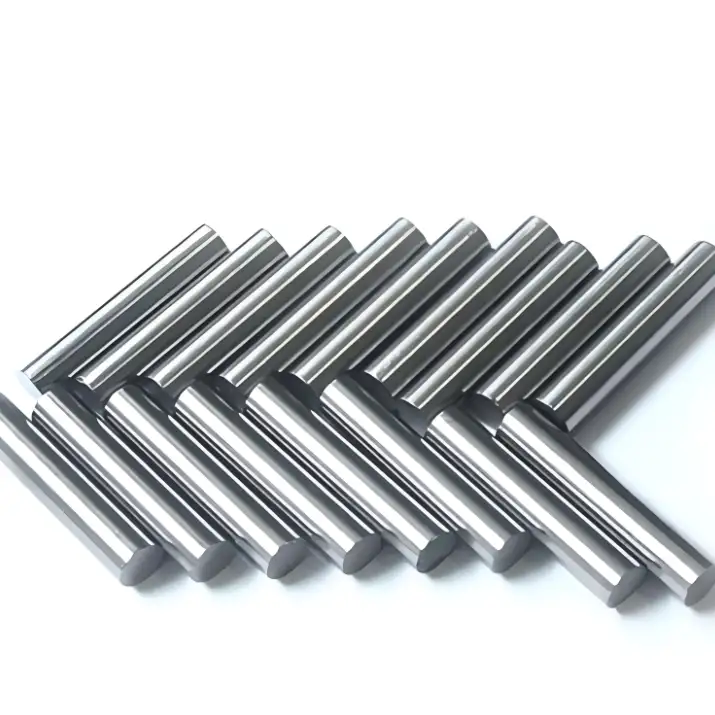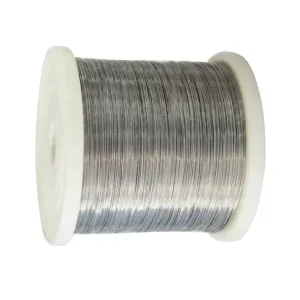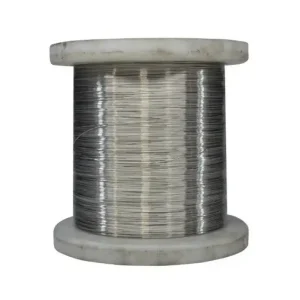At MWalloys, we engineer and supply premier Monel 400 alloy tubes, a nickel-copper alloy renowned for its exceptional resistance to a wide array of corrosive environments, from rapidly flowing seawater to harsh chemical solutions like hydrofluoric acid and alkalis. Our commitment is forged in the crucible of expertise, where we leverage decades of metallurgical know-how to produce tubing that not only meets but consistently surpasses the rigorous demands of the world's most challenging industries. We understand that for our clients in marine engineering, chemical processing, and power generation, material failure is not an option. Therefore, we meticulously control every facet of our production process, from raw material sourcing to final inspection, ensuring that every MWalloys Monel 400 tube delivers unparalleled performance, longevity, and value.
🔬 Chemical Composition of Monel 400 Alloy Tubes (Weight %)
| Element | Ni (Nickel) | Cu (Copper) | Fe (Iron) | Mn (Manganese) | C (Carbon) | Si (Silicon) | S (Sulfur) | Others |
|---|---|---|---|---|---|---|---|---|
| Min | 63.0 | 28.0 | – | – | – | – | – | – |
| Max | 70.0 | 34.0 | 2.5 | 2.0 | 0.30 | 0.50 | 0.024 | Al, Ti ≤0.5 |
| Sources: ASTM B165, EN 10025-2, JIS H4552. |
Key Notes:
-
Ni-Cu Dominance: High nickel (63–70%) ensures corrosion resistance; copper (28–34%) enhances ductility and thermal conductivity.
-
Low Impurities: Strict limits on S (≤0.024%) and C (≤0.30%) minimize brittleness and improve weldability.
💪 Mechanical Properties of Monel 400 Tubes (Room Temperature)
| Property | Tensile Strength | Yield Strength (0.2% Offset) | Elongation (%) | Hardness (HB) | Density | Melting Point |
|---|---|---|---|---|---|---|
| Value | 480–620 MPa | 170–345 MPa | 35–40% | 120–150 HB | 8.83 g/cm³ | 1300–1350°C |
| Sources: ASTM B163/B725, ASME SB163. |
Performance Insight:
-
Corrosion Resistance: Superior in seawater, HF acid, and alkaline solutions; resists chloride stress cracking.
-
Temperature Range: Stable from -196°C to 538°C (-320°F to 1,000°F).
📏 Standard Dimensions & Tolerances for Monel 400 Tubes
| Parameter | Range | Tolerance | Schedule | Form |
|---|---|---|---|---|
| Outer Diameter (OD) | 6–500 mm (0.24–19.7 in) | ±0.1 mm (精密) | SCH20, SCH40, SCH80, XS, XXS | Seamless/Welded |
| Wall Thickness | 0.5–30 mm (0.02–1.18 in) | ±10% | SCH40 (std), SCH80 (heavy) | Round, Square, Rectangular |
| Length | 1–12 m (定制至20 m) | ±6 mm (ASTM) | Random/定制 | Plain/Beveled Ends |
| Sources: ASTM B163/B730, ANSI B36.19M. |
Common Sizes:
-
Industrial: 1" OD × 2mm WT (Thick Wall)
-
Precision Electronics: 3.175mm OD × 0.5mm WT
🌐 Equivalent Grades of Monel 400 Alloy Tubes (Global Standards)
| UNS | EN (DIN) | JIS | GOST | GB/T | Common Names |
|---|---|---|---|---|---|
| N04400 | 2.4360 (NiCu30Fe) | NW 4400 | МНЖМц28-2,5-1,5 | — | Monel 400, Alloy 400 |
| N05500 | 2.4374 | — | — | — | Monel K500 (Al/Ti-strengthened) |
| — | — | — | — | EG2 | Monel EG2 (Al-enhanced) |
Grade Comparison:
-
Monel K500: Higher strength (Ti/Al added) but lower ductility; used for pump shafts/valves.
-
EG2: Similar corrosion resistance to Monel 400, with Al (2-4%) for improved heat resistance.
⚠️ Processing Guidelines
-
Welding: Use Monel 60/190 filler wires; preheat not required.
-
Machining: Low cutting speeds (30–50 m/min) with high-lubricity tools.
-
Heat Treatment: Anneal at 871–982°C for stress relief.
global price comparison 2025
| Region | Price (USD/tonne) | Notes & Source (Date) |
|---|---|---|
| China (APAC) | ≈ 43,658 USD/MT | APAC Q1 2025 |
| Europe | ≈ 38,360 USD/MT | Europe Q1 2025 |
| USA (North America) | ≈ 40,890 USD/MT | USA Q1 2025 |
🔍 Summary
-
China/APAC spot price for Q1 2025 averaged around $43,658/tonne, driven by strong infrastructure demand.
-
Europe saw levels near $38,360/tonne in the same quarter.
-
North America (USA) recorded approximately $40,890/tonne for Monel 400 tubes during Q1 2025.

Dimensions & Weights (2025)
| Outer Diameter | Wall Thickness | Approx. Weight (kg/m) |
|---|---|---|
| ½″ (12.7 mm) | 0.109″ (2.77 mm) | 0.97 |
| ¾″ (19.05 mm) | 0.154″ (3.91 mm) | 1.67 |
| 1″ (25.4 mm) | 0.154″ (3.91 mm) | 2.20 |
| 1 ½″ (38.1 mm) | 0.154″ (3.91 mm) | 3.33 |
| 2″ (50.8 mm) | 0.188″ (4.78 mm) | 5.29 |
| 3″ (76.2 mm) | 0.218″ (5.54 mm) | 8.89 |
| 4″ (101.6 mm) | 0.237″ (6.02 mm) | 13.17 |
MWalloys Monel 400 vs. The Alternatives
To truly appreciate the value proposition of our Monel 400 tubes, it's helpful to compare them against other commonly used corrosion-resistant alloys. How does it stack up against the competition?
| Feature | MWalloys Monel 400 | 316 Stainless Steel | 90/10 Copper-Nickel (C70600) |
| Primary Composition | ~67% Nickel, ~30% Copper | ~12% Nickel, ~17% Chromium, ~2% Molybdenum | ~90% Copper, ~10% Nickel |
| Seawater Resistance | Excellent, especially in high flow | Good, but susceptible to pitting and SCC | Very good, but lower strength |
| HF Acid Resistance | Excellent | Poor | Poor |
| Alkali Resistance | Excellent | Good | Fair |
| Tensile Strength (Annealed) | 70-85 ksi (480-585 MPa) | 75-95 ksi (515-655 MPa) | 40-55 ksi (275-380 MPa) |
| Cost | High | Moderate | Moderate-High |
| Key Advantage | Broad-spectrum corrosion resistance, high strength, and SCC immunity | Good general corrosion resistance at a lower cost | Excellent biofouling resistance |
As the table illustrates, while 316 stainless steel is a versatile and cost-effective choice for many applications, it falls short in chloride-rich environments where SCC is a concern and in specific chemical services like HF acid. Copper-nickel alloys are fantastic for preventing marine biofouling but lack the mechanical strength of Monel 400. Our tubes, therefore, occupy a critical space for applications where the cost of failure is high and a combination of high strength and superior, broad-spectrum corrosion resistance is non-negotiable. You're not just buying a material; you're investing in peace of mind.
Fabrication and Welding
A superior material is only as good as the ability to fabricate it into a functional component. We understand that our customers need a material that can be readily welded and formed. Monel 400 fits this bill perfectly. It can be welded using common techniques like Gas Tungsten Arc Welding (GTAW or TIG), Gas Metal Arc Welding (GMAW or MIG), and Shielded Metal Arc Welding (SMAW). We typically recommend using a matching filler metal (ERNiCu-7 for TIG/MIG) to ensure the weld zone retains the corrosion resistance and mechanical properties of the base metal.
It's important to be "clean as a whistle" when welding nickel alloys. Contamination from grease, oil, or shop dirt can lead to weld embrittlement, so meticulous cleaning before welding is paramount. Post-weld heat treatment is generally not necessary to restore corrosion resistance, which simplifies the fabrication process significantly. In terms of forming, our annealed tubes can be easily bent, flared, and machined using standard techniques, although their high strength requires more power and slower speeds compared to carbon steels. We provide comprehensive fabrication guidance to help our clients get the best results from our materials.
Quality Assurance
At MWalloys, quality is not a department; it's our culture. Our quality management system is certified to ISO 9001, and we operate with a philosophy of continuous improvement. Every tube we produce is fully traceable back to its original melt, with comprehensive material test reports (MTRs) provided as standard. These reports, often referred to as a "heat cert" in the trade, detail the precise chemical analysis and mechanical test results for that specific production batch.
Our inspection regimen includes:
- 100% Positive Material Identification (PMI): We use X-ray fluorescence (XRF) analyzers to verify the alloy composition of every single tube.
- Dimensional Checks: Laser micrometers and calipers are used to ensure strict adherence to OD, wall thickness, and length tolerances.
- Non-Destructive Testing (NDT): Depending on customer requirements, we perform eddy current, ultrasonic, or hydrostatic testing to guarantee tube integrity.
- Mechanical Testing: Tensile, hardness, and flattening tests are performed on samples from each lot to confirm mechanical properties meet specifications.
This rigorous, multi-layered approach to quality assurance ensures that when you specify MWalloys, you receive a product that is consistent, reliable, and built to perform. We don't just meet the standards; we build confidence.
Frequently Asked Questions (FAQ)
1. What is the main difference between Monel 400 and Monel K-500?
The primary difference is that Monel K-500 is an age-hardenable version of Monel 400. Small additions of aluminum and titanium are made to K-500, which allow it to be precipitation hardened through heat treatment. This results in significantly higher strength and hardness than Monel 400, while retaining excellent corrosion resistance. We supply Monel 400 for applications where high strength combined with good ductility and fabricability is needed, whereas K-500 is chosen for components like pump shafts, valve stems, and fasteners that require the utmost strength.
2. Can Monel 400 tubes be used in cryogenic applications?
Absolutely. Monel 400 is an excellent choice for cryogenic service. Unlike many ferrous materials that become brittle at low temperatures, Monel 400 actually increases in strength and hardness with decreasing temperature, while its ductility and toughness remain very high. This makes it a reliable and safe material for handling liquefied gases like LNG, nitrogen, and oxygen.
3. Is Monel 400 magnetic? Monel 400 is generally non-magnetic at room temperature. However, it can become slightly magnetic at very low temperatures or if the material is cold-worked. The temperature at which it becomes magnetic, known as its Curie temperature, is near or below ambient temperature, depending on the precise composition. For applications requiring strictly non-magnetic properties, this should be taken into consideration.
4. What is the recommended cleaning procedure before welding your tubes?
To "come clean" before welding, we recommend a thorough two-step process. First, degrease the area to be welded and the adjacent surfaces (at least 2 inches on either side) using a suitable solvent that leaves no residue. Second, use a new, clean stainless steel wire brush (one that has not been used on any other material) or a clean abrasive cloth to lightly abrade the surface to remove any thin oxide layer. This ensures a clean, sound weld free from contaminants.
5. How does the cost of MWalloys Monel 400 compare to duplex stainless steels?
Generally, Monel 400 has a higher upfront material cost than most common duplex stainless steels like 2205. This is primarily due to its high nickel content, which is a more expensive commodity than chromium. However, the total lifecycle cost can be lower in certain aggressive environments. Duplex steels, while strong and resistant to chloride SCC, do not have the same resistance as Monel 400 to certain chemicals like hydrofluoric acid or high-temperature, high-purity water. The choice often comes down to a "whole life costing" analysis, where Monel 400 is the more economical option for applications where its unique corrosion resistance prevents costly downtime and replacement.
6. Are your Monel 400 tubes certified to NACE MR0175/ISO 15156?
Yes, our Monel 400 tubes can be supplied in compliance with NACE MR0175/ISO 15156 for use in sour gas (H2S-containing) environments. The standard provides specific guidelines for the condition of the material (e.g., annealed or hot-worked) to ensure its resistance to sulfide stress cracking. When placing an order, please specify that NACE compliance is required so we can ensure the material is processed and certified accordingly.





